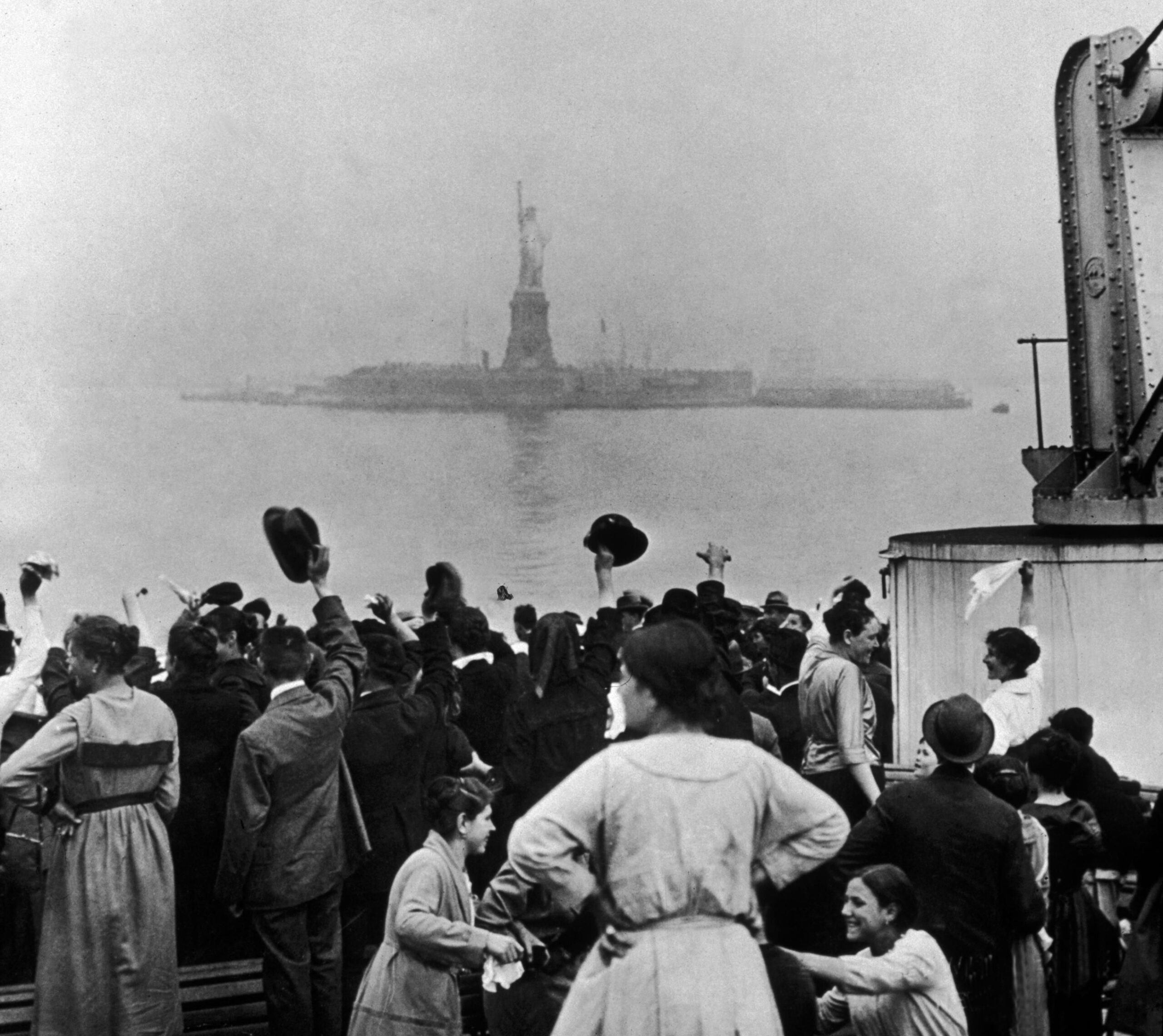‘The American Dream’, ‘The US bliss’, or just ‘bubblegum and blue jeans’ have been objects of pursuit for millions of people inside and outside of the US of A for a long time. The concept that it’s better to live in the USA, than most other countries, has been established long ago. For every negative, there is a counteractive positive, be it tangible or imagined. The Ancient Rome’s Lady Justice has weighed the pros and cons, and backed up by popular demand, established the consensus that it’s just better living here. With all the imperfections, so gloriously highlighted by the US critics and patriots alike, no other country in the world has ever accepted that many people from other lands to find their own version of the signature ‘American Dream’ along with at times shameful costs and wonderous awards associated with it.
As the immigration, which gave birth to the very concept of ‘American Dream’, dwindles down, it makes sense to examine the life it’s created. First, let’s look at the immigration itself. The first step toward it, the arrival of Mayflower, became the very cornerstone of this country and symbolizes its most cherished freedom – the freedom of religious practice. Never mind Amerigo Vespucci and Christopher Columbus exploits. It’s a little over than 100 pilgrims, who created a socialist community, Plymouth Colony. It didn’t take long for the great beginning to be marred with the cruel realities of colonialism. After being fed turkey and sheltered by the indigenous population, who later became known as Native-Americans, these freedom-hungry settlers proceeded to take their land, trick them, and later outright destroy their way of life. As typical in the older days, cities were built on the backs of commoners. Ancient Egypt boasted its architectural marvels – pyramids, which were constructed over many years, with thousands of locals and migrants dying to create them. Even Peter the Great killed tens of thousands of own people building Saint Petersburg in early 1700s. The US settlers couldn’t enslave enough locals – indigenous tribes lived with the wind in its hair, mustangs carrying them through the lands, and freedom being the greatest commodity.
Hence the next shameful part of the US history began – slavery. At first, slaves were African prisoners captured by warring tribes and sold to white people. Yet, soon after, the Westerners stopped that practice, as they needed more and more people working on building the new country. It became easier and cheaper to just steal the locals. ‘Guineamen’ began their travels across the ocean, to build the new land, and slavery became those times’ ‘forced immigration’. The US literally couldn’t get enough new residents here, as the work was vast, land underdeveloped, and the promise of prosperity overly lucrative. As slavery got abolished in 1864, it did little to improve the lives of slaves themselves at first, but the work on building this country continued. Leaving their slave plantations, slaves found themselves with no craft, food or home, so they largely settled on other plantations, presumably as ‘free men’, only to find that they’d work just as much, and get largely the same treatment, just to pay off roof over the heads and meager amount of food. Still, the tide had turned, and free labor vanished, as the source of growth for the US colonies. Luckily it coincided with easier travels, largely unavailable long distance before. As the WWI ravaged Europe in the beginning of the 20th Century, migrants from all over began their willful trips to the land of dreams, and freedom. The Statue of Liberty became a symbol of hope for many, and Emma Lazarus’ words of ‘Give me your tired, your poor, your huddled masses yearning to breathe free’ got etched in the oddest and most significant gift the French ever gave the US. It was no longer about ‘any free white person of ‘good character’’, as the Naturalization Act of 1790 dictated. It was more and more about anyone willing to come and build the country of dreams and promised prosperity. At first it was the Irish wave of immigrants. Then it was Italians and Germans and Jewish people, who took their chances here. As the Chinese began to arrive, they brought the wages down and Chinese Exclusion Act made it illegal for Chinese to seek the same opportunities, as the Europeans. In early 20th Century Japanese encountered similar restrictions. Still, New York City was made up of about 75% immigrants at that time. WWI made America refuse entry to Asian cultures. The Immigration Act of 1924 offered some regulations, albeit still favoring the ‘white Europeans’. With the African-American population still approximated at about 20%, as opposed to about 12% now, and Asian migrants pushed out due to fears of competition and ongoing wars, the US struggled to add ‘fair’ to ‘free’ in its opportunities for new population.
It wasn’t till WWII, when the immigration system began to see a new overhaul. As labor shortages were widespread, the US turned to the Southern border, yet this time for its people, not its land. The ‘bracero program’ brought Mexican workers into the country to farm the US lands. Post-WWII became so bad in Europe destroyed by Hitler’s conquests, that white Europeans overwhelmed the immigration system, and even the prohibition of Asian immigrants ended. Japanese-Americans were forcefully moved from their homes and put into camps, as a result of Japan fighting alongside Germany, but more attention was being paid to human rights and generally better living, as the world recovered after losing almost 100 million people to the Nazi invasions. The ‘socialist’ countries immigrants began to escape the grip of USSR-led efforts, and many found its home in the promised land. Russians, Cubans, Chinese, Eastern Europeans, and others ran away from countries building their prosperity via a drastically different ideological model – teachings of Karl Marx. Lyndon Johnson finally admitted the racial injustice of the US immigration system and signed the Immigration and Nationality Act of 1965 into law. Vietnamese, Cambodian, and later Cuban people were able to legally seek refuge in the US.
It wasn’t till 1986 that Ronald Reagan put forward the Simpson-Mazzoli Act and legalized illegal immigrants, who were living the States already. It also made it illegal to hire the undocumented immigrants and penalized US businesses for doing so. 2001 brought the failed DREAM Act and the best Obama could do is offer some temporary reprieve in DACA, without actually resolving what was about to become a major issue: illegal immigration, which more than doubled between 1986 and 2013. As the USSR fell apart in 1991, the countries of Easter Europe began to choose their own path. Ex-Soviet republics became own countries as well, and lack of political and ideological prosecution, known to rampage Europe for the vast majority of the 20th Century, made encouraging European immigration less feasible. ‘Free white person of ‘good character’ stopped seeking refuge in the US and largely opted to stay in their home countries to build their future. The US kept on growing and moving forward, with more and more people arriving from non-European-educated countries, such as Mexico and Guatemala, who largely came here for better economic conditions. Even Indian immigrants, who came in masses in the 90s with the technology advances, largely arrived through work visas/H-1s or came from less prosperous parts of India, resembling the Mexican migrants striving for a better economic future for themselves and their families. Once the China/US relationship normalized after Mao Tse-Tung’s passing, more Chinese people came to the US. The widespread high-level education, typical of the Chinese government’s forced efforts to better it’s society, showed up in immigrants’ success in the US. The Chinese immigration literally quadrupled by 2016, without even taking Hong Kong’s citizens moving here. Chinese immigrants attend college and graduate at double the average rate of all other immigrants.
An average US manual worker generally belongs to a labor union, thanks to Jimmy Hoffa. Those unions negotiating higher pay and better benefits for its members, often cause for such skilled labor to become unemployed due to simply being too expensive. During the Automotive industry crisis of 2008–10 General Motors and Chrysler declared bankruptcy and the US government lost over $11 billion on bailing out GM alone. Over 200,000 people got laid off from the auto industry alone, and while 8 million lost their jobs, 700,000 of those loses were due to layoffs alone. They called it ‘bad management’ mostly, as there is no math for how many of those employees got paid more, than employers could afford due to bad union deals. Hence, enter cheap manual labor.
In any big city, the absolute majority of delivery people, landscaping specialists, construction workers, carpenters, and similar, are all fairly recent immigrants, often with no language skills, and the necessity to work for any wages to put food on their table. $100 per day is the typical lowly skilled construction worker’s pay, which after 10-12 hours of work, if not more, goes below Federal and States’ minimum wage. Using George Washington’s now questionable-sounding expression of a ‘free white person of ‘good character’’, it’s safe to say that the absolute majority of those people would not perform hard manual labor at less than $10/hour. And right before it may seem like the rich taking advantage of the poor, consider that most of those employees do work for small shops, struggling to stay alive, and often owned and managed by immigrants, who rose from those low-paying roles themselves. While it was possible to find same violations at Rubaskin’s meat plants or Trump’s resorts, those cases only gathered national coverage due to their significance, while individual violations at a local food shop generally don’t get monitored, or even reported.
One thing is clear: people from all walks of life, origin, beliefs and goals want to come to the US to find a better life. Is it a better life though, and if it is, what makes it better?
As of 2018, the average US worker works more than Germans, but less than Greeks.
There is no mandated paid time off from work/vacation in the US, while Zimbabwe gets 22 days paid and France has 25 days of the same.
~2.3 million of US people are in jail, out of 331 million residents; while China jails ~1.55 million people out of 1,390 million residents at more than quadruple the US population.
15.1% of the US population lives below poverty level, compared to 10.9% in Indonesia and 4% in Austria.
With some of the best Universities in the world, just over 45% of US population has some sort of a secondary degree, compared to 56% in Canada and 50% in Israel and Japan.
People live an average of 69 years in the US, while at Japan people live to be 75, and 52 years in the war-torn Afghanistan.
As of March of 2019 the US unemployment rate was 3.9%, while the United Arab Emirates’ rate is 1.6% and Switzerland’s was 2.4%.
It’s not all about how long you live, but how you live, of course. It is the US freedom and opportunities, that attract folks, isn’t it so? Perhaps the high number of jailed people, low amount of vacation days, and even wealth inequality, aren’t that big of a deal. Perhaps the high number of police shootings, compared to low police accountability is also nothing to fret about. Mass shootings – the highest in the US among wealthy countries, don’t stop people from coming here either. Perhaps it’s all in the intent.
There is a huge difference in the eyes of the law and judicial system in this country, whether a person committed a crime intentionally or accidentally. When a citizen uses a gun to kill someone during robbery, it’s called Murder in the First Degree, and can easily land a person in jail for decades or even the rest of one’s life. Yet, when a speeding and drunk driver accidentally kills someone, it is rare to see a jail sentence exceeding 5-8 years. What has the US government done for its people then?
Most government efforts have been centered around business growth here, with citizens not being the target of well-being. Yes, Franklin Roosevelt put through The New Deal, which helped the country recover from the Great Depression, yet Reaganomics deregulated the markets, eventually causing the Great Recession of 2008; increased consumer debt, standing at the staggering $4 trillion now; and offered tax cuts to businesses, which seem to repeat themselves with every new Republican President, from G.W. Bush cuts to Paul Ryan’s seemingly childhood wet dream of 2017 Trump Tax Cuts.
Military spending for 2020 is over $1 trillion, with current military engagements in Afghanistan, Iraq, Pakistan, Somalia, Syria and Yemen; and constant talk of military threat from Iran and North Korea. The War on Terror and the International ISIS Campaign is a huge reason for it, but how did that come to be? When USSR invaded Afghanistan, the US and the Soviet Republics weren’t on friendly terms. To counteract the Soviet Union military efforts the US began to sponsor the Afghan gorilla movement, led and sponsored by the infamous Osama bin Laden. With the backing of the CIA and others, Osama created Al-Qaida, just to use it for infighting in Afghanistan, as the Soviets pulled out of that conflict in 1989. Stifled by Saudi Arabian friendly attitude toward the West/USA, he dedicated his efforts toward terrorism, and by 1990s began targeting and killing Americans, as payback for being underappreciated. Then 9/11 completely solidified his place as ‘Public Enemy #1’, and even after the US efforts to destroy Taliban and eventually killing Osama, the power vacuum of Muslim extremism was created in Afghanistan, without Taliban; and in Iraq, without Saddam. ISIL was formed and demanded greater military spending to keep in check. Dick Cheney’s search for cheap oil for his Halliburton entity may have motivated the Middle-Eastern involvement of the Bush years, yet it’s been an ongoing US search for cheap fuel for a long time, since at least 1960s, and hasn’t changed under the current President.
Perhaps looking at the trade factors would complete this picture. When Richard Nixon helped to establish China as the US source of cheap labor, and ‘made in China’ became a commonality on US goods, the plan made sense. US workers were better educated, than many others in the world; were exposed to better opportunities, and ‘service jobs’ became far more lucrative, than manufacturing. Attorneys, stockbrokers, pharmacists, financial advisors, software developers, and even sales and marketing specialists began to make far more, than a factory worker or a farmer. An ‘outsourcing effort’ of sorts occurred, by having many goods made in China and allow the American worker to build a better future/make more money locally. Then China experienced tremendous economic growth, thanks to the US consumer demand, began catching up to the US, and it brings up right to this moment, when it’s less about bringing those jobs back, and more about counteracting Chinese efforts for economic global domination. Trade Wars aren’t much better for people, than ideological wars, like the Cold War, but they still hurt everyone, including the US.
So, the question remains: what is ‘The American Dream’? The acting director of U.S. Citizenship and Immigration Services claims that there is still truth to being a ‘free white person of ‘good character’’. He even says that Emma Lazarus’ words of ‘Give me your tired, your poor, your huddled masses yearning to breathe free’ refers to ‘people coming from Europe’. He rephrased ‘Give me your tired, your poor, your huddled masses yearning to breathe free’ to ‘Give me your tired and your poor who can stand on their own two feet and who will not become a public charge’. It has always been so, as history is meant to be changed to accommodate current conditions, not so different from the Thanksgiving Day tradition being celebrated as a family day, not as a reminder of murdered residents of this country before the white people arrived. It is colonialism in the 21st Century.
Perhaps a better question would become ‘Does the US of A like its people?’



